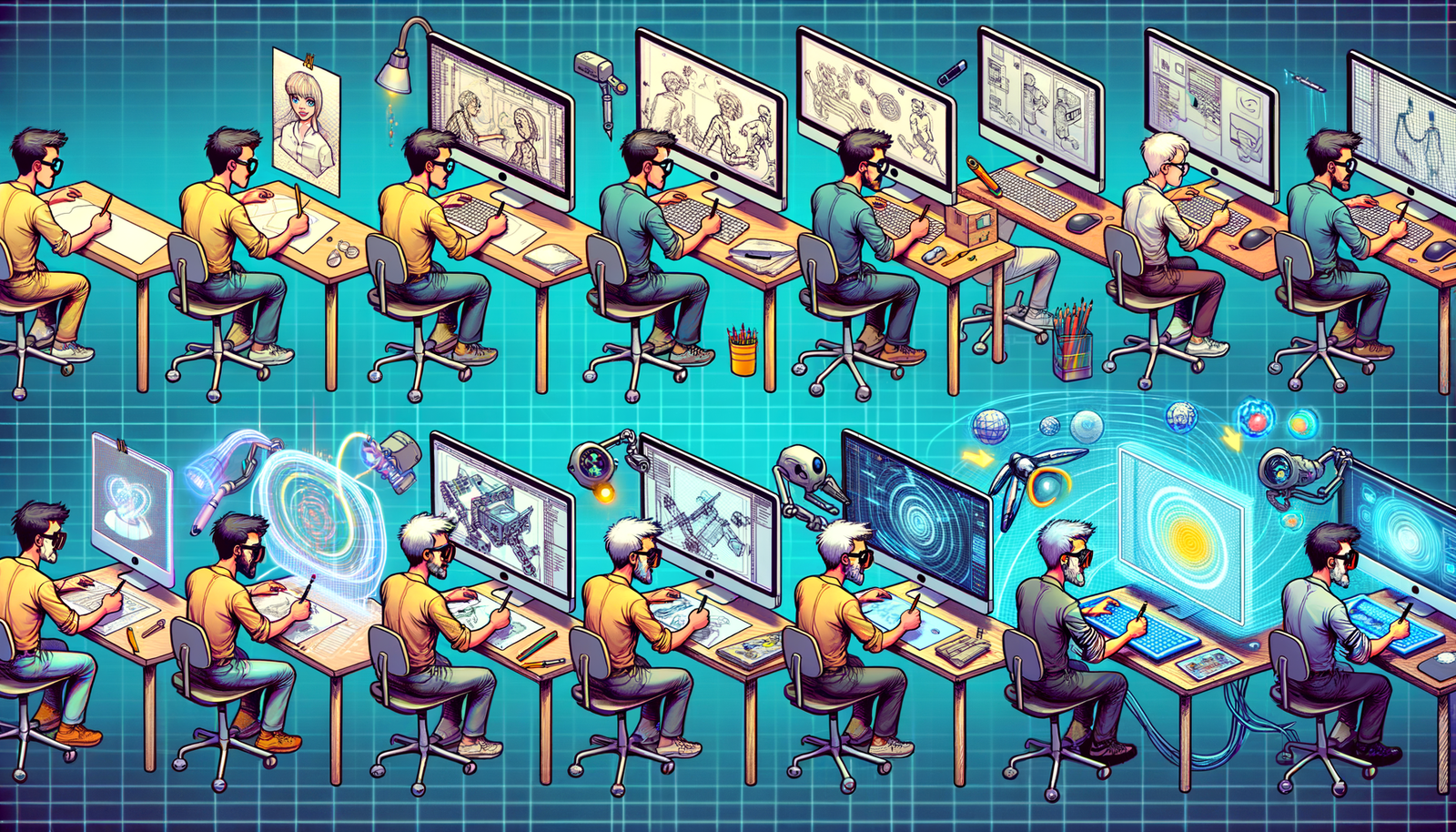Your Cart is Empty
Customer Testimonials
-
"Great customer service. The folks at Novedge were super helpful in navigating a somewhat complicated order including software upgrades and serial numbers in various stages of inactivity. They were friendly and helpful throughout the process.."
Ruben Ruckmark
"Quick & very helpful. We have been using Novedge for years and are very happy with their quick service when we need to make a purchase and excellent support resolving any issues."
Will Woodson
"Scott is the best. He reminds me about subscriptions dates, guides me in the correct direction for updates. He always responds promptly to me. He is literally the reason I continue to work with Novedge and will do so in the future."
Edward Mchugh
"Calvin Lok is “the man”. After my purchase of Sketchup 2021, he called me and provided step-by-step instructions to ease me through difficulties I was having with the setup of my new software."
Mike Borzage
Design Software History: The Evolution of Design Software: Transforming Consumer Product Development Through Technology and Innovation
January 08, 2025 7 min read


Introduction to Design Software and Its Impact on Consumer Product Design
The evolution of design software has fundamentally transformed the landscape of consumer product development. From the earliest days of manual drafting and physical prototyping to the sophisticated digital tools of the modern era, design software has revolutionized the way products are conceived, designed, and brought to market. This transformation has not only accelerated the design process but also enhanced the precision, creativity, and innovation that designers can bring to consumer products. The integration of advanced software technologies has enabled a level of complexity and customization previously unattainable, allowing companies to meet the evolving demands of consumers in a highly competitive global market.
In the early stages of consumer product design, tools and methods were predominantly manual. Designers relied on drafting tables, pencils, and paper to sketch their ideas, a process that was both time-consuming and prone to errors. The creation of physical prototypes was often necessary to visualize and test designs, leading to increased costs and extended development timelines. Communication between designers, engineers, and manufacturers was also challenging due to the lack of standardized documentation and visualization tools. The limitations of these early methods hindered innovation and made it difficult for smaller companies or individual inventors to compete with larger, well-resourced organizations.
Important milestones in the development of design software have significantly influenced consumer products. The advent of computer-aided design (CAD) in the 1960s, pioneered by innovators like Dr. Patrick Hanratty, who developed PRONTO in 1957, marked the beginning of a new era. Hanratty's work, often credited as the "Father of CAD/CAM," introduced numerical control in manufacturing, bridging the gap between design and production. In 1963, Ivan Sutherland's creation of SKETCHPAD introduced the first graphical user interface and interactive computer graphics, revolutionizing how designers interacted with computers. The launch of Autodesk's AutoCAD in 1982 democratized access to CAD software, making it affordable and accessible to a wider range of professionals. The transition from 2D to 3D modeling and the integration of simulation tools further propelled the capabilities of design software, allowing for more complex and efficient product development.
Key Technological Advances in Design Software
The transition from 2D drafting to 3D modeling marked a pivotal point in design technology, significantly enhancing the capability of designers to create more intricate and precise models. In 2D drafting, designers were limited to flat representations, which often required extensive interpretation to understand spatial relationships and dimensions fully. This limitation sometimes led to miscommunications and errors during manufacturing, resulting in increased costs and delays. With the advent of 3D modeling, designers could develop complete virtual prototypes, providing a more accurate visualization of the final product. This capability improved the ability to identify design flaws early in the process, reducing the need for costly physical prototypes and enabling more efficient collaboration among team members.
The role of parametric and solid modeling has been crucial in enhancing design precision and creativity. Parametric modeling allows designers to define attributes and parameters that govern the geometry of a design. Changes in these parameters automatically update the entire model, ensuring consistency and saving significant time during the iterative design process. Solid modeling provides a complete representation of an object's geometry, including volume and mass properties, which is essential for simulations and analyses. Software like PTC's Pro/ENGINEER, introduced in 1988, was among the first to offer parametric, feature-based, associative solid modeling, revolutionizing how designers approached complex engineering challenges.
The integration of simulation and virtual prototyping tools has further advanced efficiency in product testing and development. By simulating real-world conditions, designers can test aspects such as structural integrity, thermal performance, and fluid dynamics without building physical models. This not only reduces costs but also accelerates time-to-market for new products. For example, ANSYS provides advanced simulation software that allows for detailed analyses of product performance under various conditions, enabling engineers to optimize designs before production. These tools help in identifying potential issues early in the design phase, allowing teams to make informed decisions and adjustments that improve overall product quality.
- Cost Reduction: Minimizes the need for physical prototypes, saving materials and resources.
- Time Efficiency: Accelerates the testing process, allowing for quicker iterations and faster developments.
- Enhanced Performance: Enables optimization of designs for performance, durability, and compliance with standards.
The combination of these technological advancements has empowered designers and engineers to push the boundaries of innovation. They can now create products that are more complex, customized, and attuned to consumer needs, positioning companies to better compete in the global marketplace.
Influential Companies and Innovators in Design Software
Several companies and innovators have played pivotal roles in shaping the design software landscape. Autodesk has been instrumental in democratizing design capabilities for consumer products through its flagship product, AutoCAD. Founded in 1982 by John Walker, Autodesk recognized the potential of personal computing in making design tools accessible to a broader audience. AutoCAD's ability to run on early IBM PCs opened up opportunities for small businesses and independent designers who previously couldn't afford expensive workstation-based CAD systems. By providing powerful design tools at a fraction of the cost, Autodesk accelerated innovation across various industries.
The impact of Dassault Systèmes and SolidWorks on accessible 3D modeling for product designers is also significant. SolidWorks, introduced in 1995, was one of the first solid modeling CAD software to run on Microsoft Windows, making powerful 3D modeling tools available to a broader audience. Founded by Jon Hirschtick, SolidWorks focused on ease of use and an intuitive interface, which helped designers transition from 2D to 3D modeling seamlessly. The software's parametric design capabilities and collaboration tools have made it a staple in product development processes worldwide, influencing how products are designed across various sectors.
Contributions of pioneers such as Patrick Hanratty and Ivan Sutherland have been foundational in shaping modern design software. Hanratty's early work on PRONTO and subsequent development of the ADAM (Automated Drafting and Machining) system laid the groundwork for many of the CAD systems that followed. His emphasis on data compatibility and standardization has had a lasting impact on the industry, facilitating smoother transitions between different software platforms. Ivan Sutherland's development of SKETCHPAD introduced concepts that are now fundamental in computer graphics and design software, such as object-oriented programming and the use of graphical interfaces. His work demonstrated the potential of interactive computing, inspiring future generations of software developers and significantly advancing the capabilities of design software.
Future Trends and Challenges in Design Software for Consumer Products
Looking ahead, the exploration of advanced technologies like Artificial Intelligence (AI) and machine learning holds significant potential in design automation. AI can assist in generating design variations, optimizing shapes for performance and material usage, and predicting market trends based on consumer data. Companies like Autodesk are integrating AI into their software through tools like Generative Design, which uses algorithms to create optimized design solutions. This technology allows designers to input specific goals and constraints, and the software generates a range of viable designs, often discovering innovative forms that may not have been considered through traditional methods.
The increasing importance of sustainability and eco-friendly design is also influencing software development. As environmental concerns become more prominent, design software is integrating features that assess the environmental impact of materials and processes. For example, SolidWorks Sustainability allows designers to evaluate the carbon footprint of their products and make more environmentally conscious decisions. This focus on sustainability not only meets consumer demand for eco-friendly products but also prepares companies for stricter environmental regulations and standards.
- Lifecycle Assessment Tools: Evaluating environmental impact from raw materials to end-of-life disposal.
- Material Databases: Providing data on sustainable materials and alternatives.
- Energy Consumption Simulations: Predicting energy usage during product operation.
Challenges facing the design software industry include adapting to rapid technological changes and integration with the Internet of Things (IoT). As products become more connected and intelligent, design software must accommodate the complexity of integrating hardware with software and network connectivity. Designers now need tools that allow them to incorporate sensors, connectivity modules, and software interfaces into their designs seamlessly. Additionally, the industry must address issues related to data security, interoperability between different software platforms, and the learning curve associated with adopting new technologies.
To remain competitive, design software companies must continuously innovate and expand their capabilities. This includes developing more intuitive interfaces, integrating collaboration tools for global teams, and providing solutions that support the entire product lifecycle. The ability to adapt to new technologies like virtual reality (VR) and augmented reality (AR) for immersive design experiences will also be critical in meeting the evolving needs of designers and consumers alike.
Conclusion
Design software has profoundly influenced the evolution of consumer product design, transforming how products are conceptualized, developed, and brought to market. The advancements from manual drafting to sophisticated CAD systems have enabled designers and engineers to push the boundaries of innovation, resulting in products that are more complex, efficient, and tailored to consumer needs. The enduring impact of these technological advancements is evident in the heightened market competition and the rapid pace at which new products are introduced.
As we look to the future, design software will continue to play a critical role in shaping new consumer product experiences. The integration of AI, machine learning, and sustainability considerations will drive the next wave of innovation, allowing designers to create products that are not only advanced but also environmentally responsible. While challenges remain, particularly in adapting to rapid technological changes and integrating with emerging technologies like IoT, the industry is well-positioned to meet these demands through continued innovation and collaboration.
Ultimately, the evolution of design software reflects the broader trends in technology and society, emphasizing the importance of agility, creativity, and sustainability. By embracing these principles, designers and companies can continue to deliver products that meet the changing needs of consumers, contribute positively to society, and drive progress in the ever-evolving landscape of consumer product design.
Also in Design News
Subscribe
Sign up to get the latest on sales, new releases and more …





